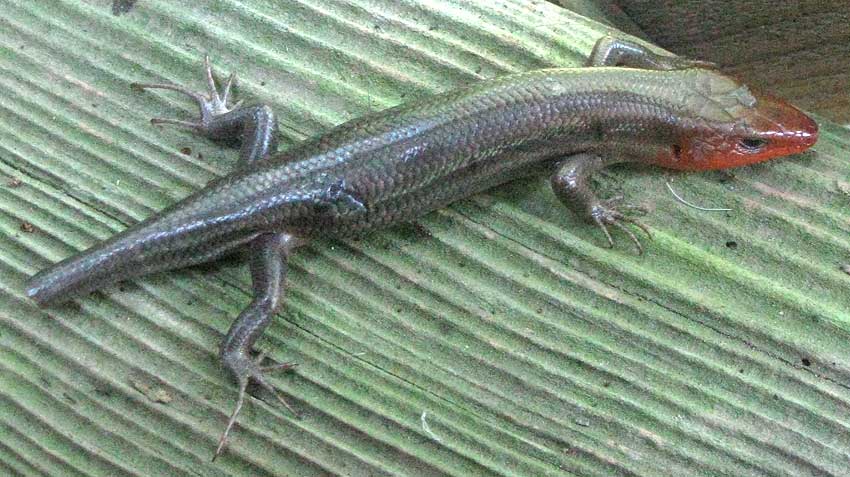Excerpts from Jim Conrad's
Naturalist Newsletter

from the June 24, 2012 Newsletter issued from the woods of the Loess Hill Region a few miles east of Natchez, Mississippi, USA
BROAD-HEADED SKINK
On the trailer's porch my food is stored in a large plastic container that mice can't get into. While digging into the container I noticed that on the shelf beside me a skink was perched watching me. Usually they run away, so thinking that maybe this one was hurt or sick I moved to make a poke with a finger, but then the critter agilely scampered to behind the container. That's when the above photograph was taken.
That skink has had a close call, as you can see by the tail's missing end, and an old wound in the side. Fracture planes cut across the tails of many skink species enabling the tail to break off easily when grasped by a predator, so maybe that happened here.
By "skink" is meant a member of the Skink Family, the Scincidae, which is the second-largest family of reptiles known generally as lizards, only the Gecko Family being larger. About 1200 skink species are known and Mississippi is home to five of them. Therefore, which species is this?
Figuring them out can be hard. Their colors can vary with age and sex. If you just have a picture as we do and can't examine such details as the anal plate on the bottom, basically you're left to noticing which scales, counting from the back's center, bear the white lines.
On that basis, ours looks like the Broad-headed Skink, EUMECES LATICEPS. Its most similar relative is the Southeastern Five-lined Skink, which also is found here, but that species' white side lines are narrower than ours. Ours is either a female or immature male, for the mature male at this time of year has a much-enlarged, almost scary looking head, a "broad head." During my hermit years near here, where my trailer was more isolated in the woods, Broad-headeds were common species, so seeing them here is to be expected.
Two months ago we looked at a Five-lined Skink from here. You might be interested in comparing our current Broad-headed with that one at http://www.backyardnature.net/n/a/5-line.htm.
The habitats of Broad-headed Skinks are described as moist, wooded areas as well as open areas where low shelter is provided by leafy debris or piles of rubble. My woods-edge trailer with its porch wall-trellises overgrown with Japanese Climbing Fern falls into that description pretty well.
from the May 5, 2002 Newsletter issued from the woods of the Loess Hill Region a few miles south of Natchez, Mississippi; elevation ~200ft (~60m), ~N31.42°, ~W91.41°; USA
A BREATH-TAKER
Sometimes I am sitting here at my computer, glance out the screen door, and my breath is simply taken. Tuesday afternoon as the temperature approached 90°(32°C) and the sun beat down the way it does in Mississippi, I gasped twice.
The first time was when I looked exactly where last week the Snout Butterflies supped on my foot-sweat, and there basked a foot-long (32cm) Broad-headed Skink, EUMECES LATICEPS. This lizard-like creature had an olive-colored body but its head was bright orange-red and monstrously equipped with swollen jowls giving its head an arrowhead shape. Smaller, more normal looking Five-lined Skinks, EUMECES FASCIATUS, getting to only about 8 inches (20cm) ramble around my outside kitchen all the time but this is the first Broad-headed I've seen here. My fieldguide says that this skink has been seen shaking the nests of paper wasps to dislodge pupae, which it eats! Broad-headeds are typically found high in the trees so I was particularly honored for him to grace my foot-sweat spot.
from the May 4, 2003 Newsletter issued from the woods of the Loess Hill Region a few miles south of Natchez, Mississippi; elevation ~200ft (~60m), ~N31.42°, ~W91.41°; USA
A SKINK ENCOUNTER
In the humid heat of Saturday afternoon (86° in my Waxmyrtle, or 30°C), there sat outside my screendoor a Broad-headed Skink, EUMECES LATICEPS. The books say this species only gets 12-3/4 inch long (32.4cm) but surely this one exceeded 13 inches. It moved slowly and deliberately, was thick and glossy, and its oversized, orange, triangular head glistened in the sunlight.
I've been watching this critter for some time, watching its orange head grow more orange and thicker as the days passed, and I assumed it was a male manifesting his hormones. Saturday I watched as this individual did something new: It curiously arched its neck so that its head bent downward like a threatening Billy goat. The reason why immediately became clear.
A considerably smaller skink, one with only a slightly orange head that wasn't at all triangular, emerged from under my door. This smaller skink approached the big skink with its neck much more arched and skewed to one side. The small one got to about a foot within the big one, then began circling to the left and, to my astonishment, proceeded to mount the big one, and the big one didn't resist.
Up on top, the little male suddenly seemed to lose his train of thought. He tumbled off no more elegantly than a dropped wiener, and as soon as he got his legs working together he stampeded ingloriously into the grass.
The big female (?) turned and gazed in his direction with the benign air of a ruminating cow looking at a fencepost, then languidly continued to beneath my trailer.